四年级英语上册ppt
- 格式:ppt
- 大小:9.29 MB
- 文档页数:21


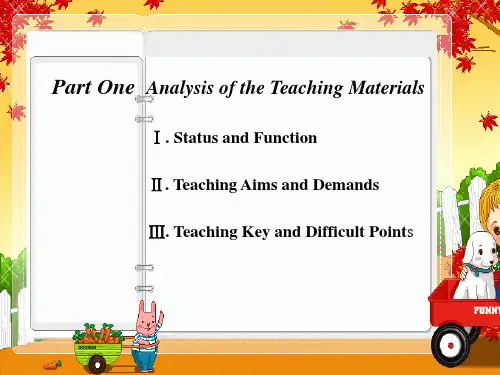

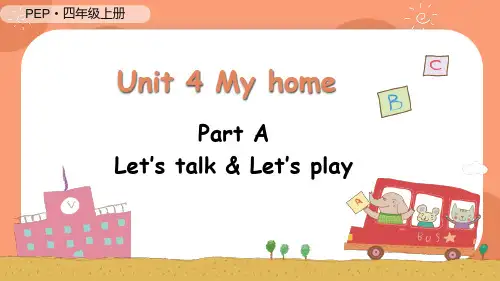
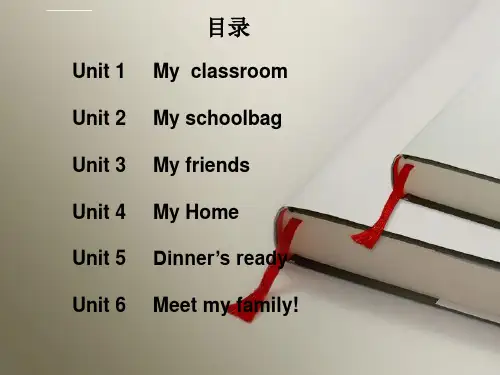


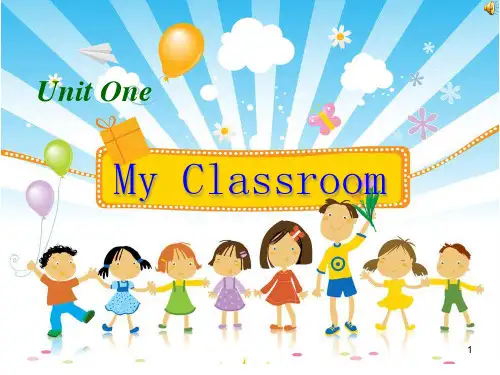
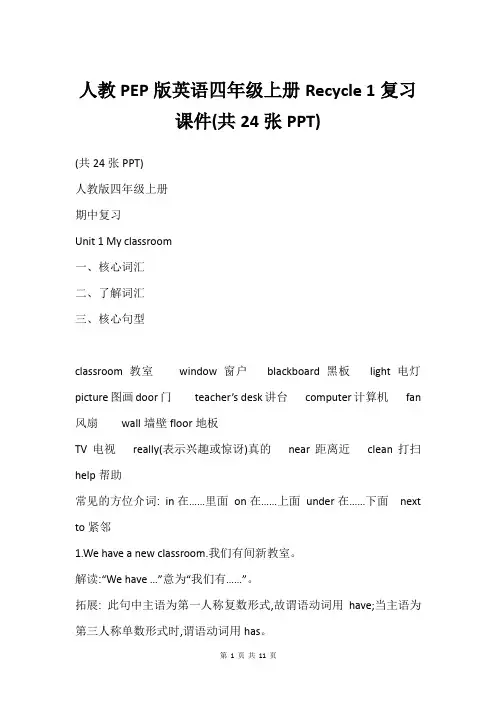
人教PEP版英语四年级上册Recycle 1复习课件(共24张PPT)(共24张PPT)人教版四年级上册期中复习Unit 1 My classroom一、核心词汇二、了解词汇三、核心句型classroom教室window窗户blackboard黑板light电灯picture图画door门teacher’s desk讲台computer计算机fan 风扇wall墙壁floor地板TV电视really(表示兴趣或惊讶)真的near距离近clean打扫help帮助常见的方位介词: in在……里面on在……上面under在……下面next to紧邻1.We have a new classroom.我们有间新教室。
解读:“We have …”意为“我们有……”。
拓展: 此句中主语为第一人称复数形式,故谓语动词用have;当主语为第三人称单数形式时,谓语动词用has。
2.Let’s go and see! 我们去看看吧!解读: let’s是let us的缩写形式, 但let’s是包括听话者在内的“我们”, let us不包括听话者。
3.—Where is it 它在哪儿?— It’s near the window.就在窗户旁边。
解读: where用来询问物体或人的位置或方位。
回答时用in, on, under, near等方位介词。
4.What’s in the classroom 教室里有什么—答:物品。
解读:这是询问某处有什么的句型,其中what’s是what is的缩写形式。
拓展:想知道某物上面/下面/附近有什么,可以用“What’s on/under/near+名词”来提问。
5.Let me clean the windows. 我来擦窗户。
解读:me是I的宾格形式。
let me后面要接动词原形。
四、a-e与a的发音1. 字母a在闭音节中,发/i/音bag has pat apple2. 字母组合a-e在开音节中,结构为:辅a辅e时,发/ei/音cake face make date五、了解句型1.开门。
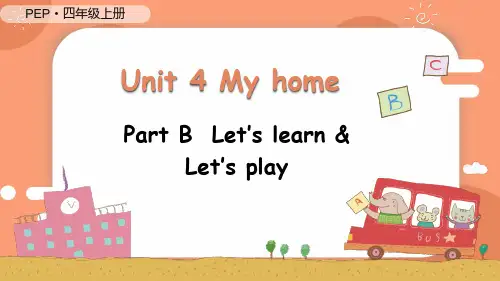
人教PEP版四年级英语上册PPT课件目录•Course Introduction and Learning Objectives•Unit Key Knowledge Sorting •Situational dialogue and cultivation of communication skills•Guide to Reading comprehension skills•Improving writing and expression skills•Listening Training and Exam01Course Introductionand LearningObjectivesCharacteristics and Content Introduction of TextbooksRich and diverse topicsThe textbooks cover a wide range of topics including school life, family, friends, hobbies, festivals,etc., which are closely related to students' daily lives and can stimulate their interest in learningEmphasis on practical language skillsThe textbooks focus on cultivating students' practical language skills through various activitiessuch as listening, speaking, reading, and writingCombination of knowledge and cultureThe textbooks are not only teaching language knowledge but also introducing culturalbackground information to help students understand the cultural differences between China andthe WestFourth grade English learning objectives•Master basic vocabulary and grammar: Students should grasp the basic vocabulary and grammar knowledge of English to play a solid foundation for future learning•Develop communication skills: Students should be able to use English to communicate with others in simple situations such as meetings, introductions, and simple conversations•Cultivate reading comprehension ability: Students should be able to read and understand simple English texts and extract key information•Foster learning interest and habits: Students should develop an interest in learning English and form good learning habits such as regular review and autonomous learningTeaching methods andstrategic suggestions•Use multimedia resources: Teachers can use multimedia resources such as PPT courseware, videos, and audio materials to enrich the teaching content and stimulate students' interest in learning •Create authentic language environments: Teachers should create authentic language environments for students to practice their English communication skills•Encourage cooperative learning: Teachers can resource students to work in groups to complete tasks and activities, which can help them develop team work skills and improve their motivation to learn •Different instruction: Teachers should have different instruction according to students' different learning needs and abilities to ensure that each student can achieve their potential in English learning02Unit KeyKnowledgeSortingClassroomDoor Teacher's desk Computer BlackboardWindowa room where teachers teach students an opening in a wall, door, or roof to let in light andair a large, flat surface that is commonly black and that you write on with talk in a classroom an opening in a wall that you can open and close,usually with a handlea desk in a classroom where the teacher stands to teachan electronic device that stores and processes data, and that you can use for tasks such as writingdocuments, browsing the internet, and playing gamesUnit 1 Key Vocabulary and Phrases"There is a..."/"There are..." to describe the existence of something There is a presence structure "I am doing..."/"He/She is doing..." to describe actions that are happeningnowPresent continuous tense"I have..."/"He/She has..." to describe things that people have or have less Simple present tense "in", "on", "under", "near" to describe the position of objects Positions of placeUnit 1 Core Sentence Patterns and Grammar Analysis01Schoolbaga bag that you use to carryyour books and other things to and from school 02Math book a book that contains math problems and exercises 03English book a book that contains English language lessons 04Chinese booka book that contains Chinese language lessons 05Pencil case a small container that you use to hold pencils, pens, and other writing tools 06Storybook a book that contains stories Unit 2 Key Vocabulary and PhrasesUnit 2 Core Sentence Patterns and Grammar Analysis01"I have got..."/"He/She has got..." to express session02Can do something structure: "I can..."/"He/She can..." toexpress capability03Simple present tense with third person singular: "He/Shedoes..." to describe hats or routes04Adjectives to describe objects: "big", "small", "heavy", "light" todescribe the size or weight of objects03Situationaldialogue andcultivation ofcommunication skillsAnalysis of scenario dialogue examplesExtract key informationIdentify the main characters, settings, and plotlines in thedialogue examplesLanguage featuresAnalyze the language used in the dialogue, includingvocabulary, grammar, and promotionCultural backgroundExplain any cultural references or customs that may beunfriendly to studentsCommunication skills guidance and trainingListening skillsTeach students how to listenactively and extract keyinformation from Spoken EnglishSpeaking skillsEnhance students to practicespeaking fluently and clearly, withemphasis on promotion andintegration Interpersonal skills Train students in basicinterpersonal communicationskills, such as greeting,apologizing, and expressingthanksSituation selectionChoose situations that are relevant to the students' lives and interests Assign roles to studentsbased on their personalitiesand language abilitiesProvide necessary props andcosts to enhance theauthenticity of the role playingexperienceEvaluate students'performance based on theirlanguage use,communication skills, andcreativityRole allocation Activity preparation PerformanceevaluationRole playing activity design04Guide toReadingcomprehension skillsPrinciples for selecting reading materialsSuitability for students' English levelMaterials should be neither too difficult nor too easy, but just right to challengeand improve students' reading abilityDiversity of topics and genresExposing students to a wide range of topics and genres can help broaden theirhorizons and develop their interest in readingAuthenticityUsing authentic materials such as news articles, stories, and essays can helpstudents develop a better understanding of English language use in real worldcontextsAnalysis of Reading comprehension question typesMain idea and detail questionsThese questions test students' understanding of the overall theme and specific details of the textVocabulary and grammar questionsThese questions focus on specific words, phrases, or grammatical structures used in the textInference and critical thinking questionsThese questions require students to make inferences based on the information provided in thetext and to think critically about the contentSharing of answering skills and strategies•Previewing the questions before reading: This strategy can help students focus on key information while reading and improving their comprehension efficiency•Skimming and scanning: Skimming investments quickly reading through the text to get a general idea of the content, while scanning investments searching for specific information•Guessing the meaning of unknown words: Students can use context clubs, word formation knowledge, and their own background knowledge to see the meaning of unknown words •Reading for detail: When answering detailed comprehension questions, students should reread the relevant part of the text carefully to ensure they have all the necessary information05Improvingwriting andexpressionskillsIntroduction to Basic Writing RequirementsUnderstanding the writing formatIntroduce the basic format requirements of English writing, includingparagraph structure, punctation, and capitalizationMastering basic vocabulary and grammarEmphasize the importance of basic vocabulary and grammar in writing, andprovide examples and exercises to help students master themDeveloping writing ideasGuide students to develop writing ideas by brainstorming, outlining, and otherpre writing activitiesCorrection of common writing errorsGrammatical errorsIdentify and correct common graphical errors, suchas subject verb agreement, tense consistency, andpresence structureSpelling errorsPoint out common spelling errors and provide tipsfor improving spelling accuracyPuncturation errorsExplain the correct usage of puncture marks, suchas commas, periods, and quota marks, and correctrelated errorsAnalyzing model assessmentsSelect multiple Excel model assessments and analyze their structure, language use, and writing techniquesLearning from model essaysEncourage students to learn from the strengths of model essays and apply them to their own writingImproving writing skills through practiceProvide writing prompts and exercises to help students practice and improvetheir writing skills based on what they have learned from model essaysRecommendation and reference of Excel model essays06ListeningTraining andExamStrategies01 02 03Choose authentic English materials Select materials that are produced by native speakers and feature real life scenarios to expose students to natural language useVary the diversity levelGradually increase the complexity of the listening materials to challenge students and improve their comprehension skillsIncorporate a range of topicsIntroduce a variety of topics to keep students engaged and broad their vocabulary and understanding of different subjectsSuggestions for selecting listening materialsIdentify question typesFamiliarize students with different types of listening questions, such as multiple choices, true or false, and fill in the blanksEncourage students to takenotes while listening,focusing on key words andphrases to aid in recall andcomprehensionTrain students to usecontext clubs and theirexisting knowledge topredict possible answersbefore hearing the entirequestion or response Teach notetakingstrategiesDevelopprediction skillsAnalysis of listening question types and problem solving skillsSimulation testing and self-assessment•Conduct regular practice tests: Administrator simulatedlistening tests to help students become family witTHANKS感谢观看。